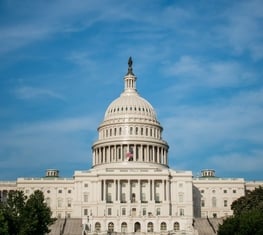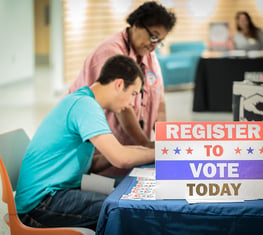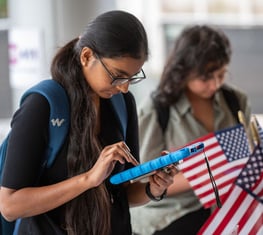By Carolyn Jefferson-Jenkins and Margaret Hawkins Hill
Defining League Positions in Public Education
The League of Women Voters United States (LWVUS), through its positions on equality of opportunity, supports public education and a range of federal education programs. Areas where specific positions were developed are: integration, quality education, tuition tax credits, federal programs and education financing. Some programs are designed to meet the needs of special education students as well as the economically disadvantaged and ethnic minority students. The League worked for the passage of Title IX of the Education Amendment of 1972 that prohibits sex discrimination in educational institutes that receive federal aid. Historically, many state Leagues have their own positions that speak to equality, to funding, and to assessments and standards at the state level. Additionally the League, under its position on early intervention for children at-risk addresses issues related to the federal role in public education. To understand and reach consensus on the present and future role of the federal government in public education, it is important that we have some understanding of the history of the federal government’s role in education activities. This paper and the links provided on the LWVUS website (www.lwv.org) delineate the materials that support this study.
Where Have We Been?
From the very beginning of our Republic, a well-educated citizenry was thought to be essential to protect liberty and the general welfare of the people. Even before the Constitution of the United States was established, the Land Ordinance of 1785 and the Northwest Ordinance of 1787 included responsibilities of the nation for an education system. Education has long been considered a national concern by the federal government. Through federal action, education has been encouraged and financially supported from the first Northwest Ordinance in 1787 to the present. Article 1, Section 8, of the Constitution granted Congress the power to lay and collect taxes to provide for the general welfare of the United States. It is under this “general welfare” clause that the federal government has assumed the power to initiate educational activity in its own right and to participate jointly with states, agencies and individuals in educational activities.
During the first century of the new nation, Congress granted more than 77 million acres of the public domain as an endowment for the support of schools through tracts ceded to the states for the support of public schools. In 1841, Congress passed an act that granted 500,000 acres to eight states and later increased grants to a total of 19 states. The federal government also granted money to states, such as distributions of surplus federal revenue and reimbursements for war expenses. Though Congress rarely prescribed that such funds be used only for schools, education continued to be one of the largest expenses for state and local governments, so the states used federal funds whenever possible.
Two Constitutional Amendments played an important role in public education. In 1791, the 10th Amendment stated, “The powers not delegated to the United States by the Constitution, nor prohibited by it to the States, are reserved to the States respectively, or to the people.” Public education was not mentioned as one of those federal powers, and so historically has been delegated to the local and state governments.
In 1868, the 14th Amendment guaranteed rights to all citizens by stating “all persons born or naturalized in the United States, and subject to the jurisdiction thereof, are citizens in the United States and of the state wherein they reside. No state shall make or enforce any law which shall abridge the privileges or immunities of citizens of the United States; nor shall any state deprive any person of life, liberty or property, without due process of law; nor deny to any person within its jurisdiction the equal protection of the law.”
From colonial times through the early 19th century, before common schools became an established part of society, children were educated in an assortment of institutions and arrangements mostly supported by local entities.
During the 19th century the federal government involvement in education included vocational training, land grants, and the establishment in 1867 of the Office of Education. The purpose of this office was to collect information on schools and teaching that would help states establish effective school systems.
The passage of the Second Morrill Act in 1890 gave the Office of Education responsibility for administering support for the original system of land-grant colleges and universities. Vocational education became the next major area of federal aid to schools with the 1917 Smith-Hughes Act followed by the 1946 George-Barden Act focusing on agriculture, industrial arts and home economics training for high school students.
World War II led to a significant expansion of federal support for education. The Lanham Act of 1941 and the Impact Aid laws of 1950 eased the burden on communities affected by the presence of military and other federal installations by making payments to school districts. In 1944 the GI Bill authorized postsecondary education assistance that would ultimately send nearly 8 million WWII veterans to college.
The Supreme Court handed down the landmark decision Brown v. Board of Education in 1954, declaring state laws that established separate public schools based on race unconstitutional. In 1958, Congress passed the National Defense Education Act (NDEA) in response to the Soviet launch of Sputnik. This legislation included support to teachers through graduate fellowships to improve the teaching of science, mathematics and foreign languages.
The anti-poverty and civil rights laws of the 1960s and 1970s dramatically increased the role of the federal government in public education. Laws passed included Title VI of the Civil Rights Act of 1964, Title IX of the Education Amendments of 1972 and Section 504 of the Rehabilitation Act of 1973 prohibiting discrimination based on race, sex and disability.
How Did We Get Here?
In 1965 the Elementary and Secondary Education Act (ESEA Pub.I.89-1- Stat 27, 20 U.S.C. ch 70) launched a comprehensive set of programs including Title I program of federal aid to the disadvantaged. The Act funds primary and secondary education, while explicitly forbidding the establishment of a national curriculum. As mandated in the Act, the funds are authorized for professional development, instructional materials and resources to support educational programs and parental involvement promotion. The Act was originally authorized through 1970; however, the government has authorized the Act every five to ten years since its enactment. The current reauthorization of ESEA is called the No Child Left Behind Act of 2001 (NCLB). NCLB also allows military recruiters to access 11th and 12th grade students’ names, addresses and telephone listings when requested.
In 1980, Congress established the Department of Education as a Cabinet level agency. Then, for the next 12 years under Presidents Ronald Reagan and George H.W. Bush, education was a priority issue. The religious and private sectors were involved as well, with introductions of tax credits, parental involvement and vouchers. Additionally, in 1982, twenty-five bills were introduced to improve math and science instruction, but all failed in Congress. The tuition tax-credit was proposed for mainly religious schools but broadened to private school tuition in 1983. This too, failed. In 1983, the publication of A Nation At Risk brought the competitive nature of education to the forefront, warning that the United States no longer held the education edge when compared to the rest of the world.
In 1989, President George H. W. Bush signaled public school choice to be a “high priority.” He also formed a task force to study Hispanic education and called for an “Indian education bill of rights” to help improve education for Native Americans. Drug education also came to the forefront during his Administration. In 1991, President Bush formed the National Education Goals Panel to create a national assessment system to measure progress toward the national education goals for 2000. In that same year, Congress passed a bill to create a national council on education standards and testing, the purpose of which would be to study the feasibility and desirability of creating national standards and a national examination system for students.
During President Bill Clinton’s administration, education achievement focused on the Goals 2000 competitive grants. School districts realized significant gains by using these funds. However, the grants were only awarded to those districts that had the resources to write the grants and study their implication.
President George W. Bush made education issues a priority. NCLB, as described above, was one of the first bills passed by Congress during his Administration.
Where Are We Now?
The United States has changed dramatically since the early debates on the role of public schools and the role of the federal government in supporting and sustaining them. The importance of education for the common good has shifted from primarily local control to state and national control, with national attention from the Federal government and national organizations. Congress is currently embroiled in a debate and stalemate over the reauthorization of ESEA, the 2001 NCLB. Major issues include the purpose and role of the federal government in education, funding, and the extent to which the federal government should play a role in public education. Areas for national debate involve school choice, accountability, teacher quality, goals, standards and above all, funding. Federal funding currently averages about 10 percent of local school budgets.
During the coming year, local and state Leagues across the United States will discuss the role of the federal government in public education with the goal of coming to consensus on a number of questions.
References
Books:
Darling-Hammond, L., (2010). The flat world and education: How America's commitment to equity will determine our future. New York: Teachers College Press.
Ravitch, D. (2010). The death and life of the great American school system: How testing and choice are undermining education. New York: Basic Books.
Theobald, P. (2009). Education now: How rethinking America's past can change its future. Boulder, Colorado: Paradigm Publishers.
Online links:
National Commission on Excellence in Education. (1983). A Nation at Risk. Retrieved from http://www2.ed.gov/pubs/NatAtRisk/risk.html
National Governors Association Center for Best Practices and Council of Chief State School Officers (2010). Common Core Standards. Retrieved from http://www.corestandards.org
U.S. Department of Education (2002). Elementary and Secondary Education Act. Retrieved from http://www.ed.gov/policy/elsec/leg/esea02/index.html
U.S. Department of Education (2010). Reauthorization of the Elementary and Secondary Education Act. Retrieved from http://www.ed.gov/blog/topic/esea-reauthorization
ADDENDUM to “Role of Federal Government in Public Education: Historical Perspectives”
Federal Acts and Court Cases Involving Federal Role in Public Education
Event |
Date |
Explanation |
|
Land Ordinance & Northwest Ordinance |
1785/1787 |
Required a system of public education to be established in each township formed under a specified formula. Regulated monies raised via selling or renting land, or taxes. |
|
Land Grants |
1841/1848 |
Congress granted 77+ million acres of land in the public domain as endowments for support of schools. Federal government also granted surplus money to states for public education. |
|
Early philosophy – first six presidents |
1790-1820 |
Discussed a national university and urged federal involvement in public education. Seen as critical to preparation for citizenship in a republican form of government. |
|
First Morrill Act otherwise known as the Land Grant Act |
1862 |
Donated public lands to states to be used for the endowment to support and maintain at least one college with specific purpose of teaching agriculture, mechanic arts and industrial education. |
|
The original Department (Office) of Education established |
1867 |
Began to collect data – information on schools and teaching that would help states establish effective school systems. |
|
Second Morrill Act |
1890 |
Gave the Office of Education responsibility for administering support for the original system of land-grant colleges. |
|
Smith-Hughes Act |
1917 |
Promoted vocational schools. Repealed 1997. |
|
Lanham Act Impact Aid laws |
1941 1950 |
Eased the burden on communities affected by presence of military and federal installations through payments to school districts. |
|
GI Bill |
1944 |
Provided post secondary education assistance to GIs returning from WW II. |
|
George-Barden Act |
1946 |
Provided funding for agricultural, industrial and home economics training for high school students. |
|
National Defense Education Act |
1958 |
In response to Soviet Sputnik. NDEA included support for loans to college students in science, mathematics and foreign languages. |
|
Elementary and Secondary Education Act |
1965 |
Established comprehensive set of programs, including Title I of federal aid to disadvantaged. |
|
Title IX |
1972 |
Prohibited discrimination in education based on gender. |
|
Section 504 of the Rehabilitation Act |
1973 |
Prohibited discrimination based on disability. |
|
Department of Education made a cabinet level agency |
1980 |
Recognized the important role of public education. |
|
Educational Testing Service (ETS) |
1983 |
Federal government transferred responsibility for administering the National Assessment of Educational Progress (NAEP) to ETS. |
|
Nation at Risk |
1983 |
Published report indicating that the United States was falling behind in education achievement. |
|
President G.H. Bush |
1989-1992 |
“Indian Education Bill of Rights” |
|
President W. Clinton |
1993-1999 |
Academics 2000 offered grants to states and local school districts for innovative programs. |
|
President G.W. Bush |
2001-2008 |
Reauthorization of ESEA – No Child Left Behind. |
|
President Barack Obama |
2009 - |
President Obama’s Blueprint for Reform – Reauthorization of ESEA. |
Government Actions and Court Cases
Two of our constitutional amendments play an important role in public education.
The 10th Amendment proclaims that anything not included in the U.S. Constitution is reserved for the States. “The powers not delegated to the United States by the Constitution, nor prohibited by it to the States, are reserved to the States respectively, or to the people.” Thus, public education became a states’ rights mandate and one that developed over time to have education funded by both state and local governments.
The 14th Amendment guarantees rights to all citizens. “All persons born or naturalized in the United States, and subject to the jurisdiction thereof, are citizens of the United States and of the state wherein they reside. No state shall make or enforce any law that shall abridge the privileges or immunities of citizens of the United States; nor shall any state deprive any person of life, liberty or property, without due process of law; nor deny to any person within its jurisdiction the equal protection of the law.”
Beginning in 1791, there have been many Supreme Court decisions and federal government laws that impact public education, providing greater equity for citizens.
1791: Bill of Rights of the Constitution was passed. No mention is made of education in any of the amendments. However the 10th Amendment states that powers not delegated to the federal government are reserved to the states or to the people. Thus, education became a function of the state rather than the federal government.
1896: Plessy v. Ferguson ruled that “separate but equal” policies would be legal.
1925: Tennessee v. John Scopes (“the Monkey Trial”) captured national attention as John Scopes, a high school biology teacher, was charged with teaching evolution. The trial ended with Scopes’s conviction.
1931: Alvarez v. the Board of Trustees of the Lemon Grove (California) School District became the first successful school desegregation court case in the United States and referred to placing Mexican-American children in separate schools.
1946: Mendez v. Westminster and the California Board of Education ruling by the Supreme Court that educating Mexican-American children in separate facilities was unconstitutional.
1947: Everson v. Board of Education ruled that the New Jersey law allowing reimbursements of transportation for children to get to school (even religious schools) did not violate the Establishment clause of the First Amendment.
1948: McCollum v. Board of Education ruled that schools couldn’t allow religious education (called “released time”) during the school day in public school classrooms.
1950: Public Law-740 granted a federal charter to Future Farmers of America and recognized it as an integral part of public vocational education. Revised in 1998 as Public Law 105-225.
1954: Brown v. Board of Education of Topeka ruled that “separate but equal” as ruled under Plessy v. Ferguson was not legal. It was the historic first step for equality in public education.
1965: Elementary and Secondary Education Act (ESEA) provided federal funds to help low-income students and included such segments as Title 1 support for children in math and reading who fell behind and included bilingual education.
1968: The Bilingual Education Act also known as Title VII. The law was repealed in 2002, but bilingual education was placed under No Child Left Behind.
1968: Epperson v. Arkansas ruling by the Supreme Court that the state of Arkansas’s law prohibiting the teaching of evolution in public schools or universities was unconstitutional.
1970: Diana v. California State Board required that children referred for special education placement be tested in their primary language if possible.
1971: Pennsylvania Association for Retarded Children (PARC) v. Pennsylvania determined that students with mental retardation are entitled to free public education.
1972: The Indian Education Act became law and established a “comprehensive approach” to meeting the unique needs of American-Indian and Alaskan-Native students.
1972: Mills v. The Board of Education of Washington DC extended PARC v. Pennsylvania ruling for students with disabilities, requiring provisions of “adequate alternative educational services suited to the needs of the child.”
1973: The Rehabilitation Act became law with Section 504 guaranteeing civil rights for people with disabilities and required accommodations in schools including participation in programs and activities as well as access to buildings. Today “504 plans” are used to provide accommodations for students with disabilities, who do not qualify for special education under Individual Education Plans.
1975: The Education of all Handicapped Children Act (PL94-142) required that a free, appropriate public education, suited to the student’s individual needs and offered in the least restrictive environment, be provided for all “handicapped” children. States were given until 1978 to comply;this was later extended to 1981.
1982: Edwards v. Aguillard ruling by the Supreme Court invalidated Louisiana’s “Creationism Act” that required the teaching of creationism whenever evolution was taught.
1982: The Board of Education v. Pico ruling by the Supreme Court that books could not be removed from a school library because school administrators deemed their content to be offensive.
1984: Public Law 105-332, the Carl D. Perkins Vocational and Technical Education Act was passed with the goal of increasing the quality of vocational-technical education in the United States. It was reauthorized in 1998 and, again, in 2006 as the Carl D. Perkins Vocational and Technical Education Act (PL 109-270).
1984: The Emergency Immigration Education Act was enacted to provide services and offset the costs for school districts that had unexpectedly large numbers of immigrant students.
1985: Wallace v. Jaffree ruling by the Supreme Court that Alabama’s statutes authorizing silent prayer and teacher-led voluntary prayer in public schools violated the First Amendment.
1990: Public Law (101-476), The Individual with Disabilities Education Act (IDEA) renames and amends Public Law 94-142. It changed the terminology from “handicapped” to “disability.” It mandated transition services and added autism and traumatic brain injury to the eligibility list.
1998: The Higher Education Act was amended and reauthorized, requiring institutions and states to produce “report cards” about teacher education.
2000: Santa Fe School District v. Doe ruled that the district’s policy of allowing student-led prayer prior to football games violated the Establishment clause of the First Amendment.
2001: No Child Left Behind Act approved, reauthorizing ESEA of 1965 and holding schools accountable for student achievement levels by providing penalties for schools not meeting adequate yearly progress toward those goals.
2002” Zelman v. Simmons-Harris ruling by the Supreme Court that certain school voucher programs were constitutional and did not violate the Establishment clause of the First Amendment.
2004: Alignment of IDEA with NCLB. IDEA became the Individuals with Disabilities Education Improvement Act (IDEIA).
2005: Kitzmiller v. Dover Area School District ruled that teaching “intelligent design” as an alternative to evolution is a violation of the First Amendment.
2009: American Reinvestment and Recovery Act provided more than 90 billion dollars for education, nearly half of which goes to local school districts to prevent layoffs and for school modernization and repair. It included the “Race to the Top” competitive grant.
2009: Common Core Standards initiative developed possible national standards by a coordinated effort of Chief State School officers and Governors Association Center for Best Practices.
Carolyn Jefferson-Jenkins (LWVCO) is a member of the LWVEF Education Study Committee on the Role of the Federal Government in Public Education. Margaret Hawkins Hill (LWVTX) is co-chair of the LWVEF Education Study Committee on the Role of the Federal Government in Public Education.
Produced by The Education Study: The Role of the Federal Government in Public Education, 2011
©2011 by the League of Women Voters
The Latest from the League
After the election, I joined fellow members of the League of Women Voters of DC to register new voters at a naturalization ceremony. It was my first time at one; I was uncertain of what to expect.
This year, in addition to helping register a record number of new voters in 2018, 853 League volunteers dedicated 6,600 hours of their time to inform, assist, and engage with over 47,000 new citizens at the ceremonies nationwide.
With five short weeks before Election Day, now is the time to get the information you need so that you can participate in the 2018 midterms and the League is here to help!
Sign Up For Email
Keep up with the League. Receive emails to your inbox!
Donate to support our work
to empower voters and defend democracy.




